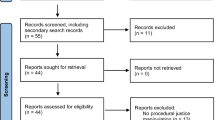Abstract
Recently, serious questions have been raised about the validity of cross-sectional (“one-wave”) assessments of perceptual deterrence. Panel (“multiwave”) designs have, therefore, become the preferred method of conducting perceptual deterrence research. We question whether panel designs are always necessary. Our goal is to encourage renewed examination of cross-sectional designs. The primary method of accomplishing this goal is replication and extension of an earlier one-wave study. Following a review of the design issue, the paper continues with a brief description of the study to be replicated and extended. Presented next are the replication methods and findings. The paper ends with a discussion of the contours of an agenda for future research.
Similar content being viewed by others
References
Anderson, L. S., Chiricos, T. G., and Waldo, G. P. (1977). Formal and informal sanctions: A comparison of deterrent effects.Soc. Problems 25: 103–114.
Bishop, D. M. (1984). Legal and extralegal barriers to delinquency: A panel analysis.Criminology 22: 403–419.
Burkett, S. R., and Jensert, E. L. (1975). Conventional ties, peer influence, and the fear of apprenhension: A study of adolescent marijuana use.Sociol. Q. 16: 522–533.
Elliot, D. S., Ageton, S. S., and Canter, R. (1979). An integrated theoretical perspective on delinquent behavior.J. Res. Crime Delinq. 16: 3–27.
Erickson, M. L., Gibbs, J. P., and Jensen, G. F. (1977). The deterrence doctrine and the perceived certainty of legal punishments.Am. Sociol. Rev. 42: 305–317.
Erickson, P. G. (1976). Deterrence and deviance: The example of cannabis prohibition.J. Crim. Law Criminol. 67: 222–232.
Flanagan, T. (1983). Correlates of institutional misconduct among state prisoners: A research note.Criminology 21: 29–39.
Gottfredson, S. D., and Gottfredson, D. M. (1980). Screening for risk: A comparison of methods.Crim. Just. Behav. 7: 315–330.
Greenberg, D. F. (1981). Methodoligical issues in survey research on the inhibition of crime.J. Crim. Law Criminol. 72: 1092–1101.
Greenberg, D. F., Kessler, R. C., and Logan, C. H. (1979). A panel model of crime rates and arrest rates.Am. Sociol. Rev. 44: 843–850.
Hanushek, E. A., and Jackson, J. E. (1977).Statistical Methods for Social Scientists, Academic Press, New York.
Hindelang, M. (1974). Decisions of shoplifting victims to invoke the criminal justice process.Soc. Problems 21: 580–593.
Hirschi, T. (1969).Causes of Delinquency, University of California Press, Berkeley.
Hirschi, T., and Gottfredson, M. (1983). Age and the explanation of crime.Am. J. Sociol. 89: 552–584.
Josephson, E., and Rosen, M. (1978). Panel loss in a high school drug study. In Kandel, D. (ed.),Longitudinal Research in Drug Use, Hemisphere, Washington, D.C., pp. 115–136.
Kessler, R. C., and Greenberg, D. F. (1981).Linear Panel Analysis: Models of Quantitative Change, Academic Press, New York.
Meier, R. F., and Johnson, W. T. (1977). Deterrence as social control: The legal and extralegal production of conformity.Am. Sociol. Rev. 42: 292–304.
Minor, W. W., and Harry, J. (1982). Deterrent and experiential effects in perceptual deterrence research: A replication and extension.J. Res. Crime Delinq. 19: 190–203.
Paternoster, R., Saltzman, L., Waldo, G. P., and Chiricos, T. G. (1983). Perceived risk and social control: Do sanctions really deter?Law Soc. Rev. 17: 457–479.
Petersilia, J. (1980). Criminal career research: a review of recent evidence. In Morris, N., and Tonry, M. (eds.),Crime and Justice: An Annual Review of Research, University of Chicago Press, Chicago.
Piliavin, I., Gartner, R., Thornton, C., and Matsueda, R. L. (1986). Crime, deterrence, and rational choice.Am. Sociol. Rev. 51: 101–119.
Saltzman, L., Paternoster, R., Waldo, G. P., and Chiricos, T. G. (1982). Deterrent and experiential effects: The problems of causal order in perceptual deterrence research.J. Res. Crime Delinq. 19: 172–189.
Teevan, J. J., Jr. (1976). Subjective perceptions of deterrence.J. Res. Crime Delinq. 13: 155–164.
Tittle, C. R. (1977). Sanction fear and the maintenance of social order.Soc. Forces 55: 579–596.
Waldo, G. P., and Chiricos, T. G. (1972). Perceived penal sanctions and self-reported criminality: A neglected approach to deterrence research.Soc. Problems 19: 522–540.
Wilkins, L., and McNaughten-Smith, P. (1964). New prediction and classification methods in criminology.J. Res. Crime Delinq. 1: 19–32.
Williamson, J. B., Karp, D. A., and Dalphin, J. R. (1977).The Research Craft: An Introduction to Social Science Methods, Little, Brown, Boston.
Author information
Authors and Affiliations
Rights and permissions
About this article
Cite this article
Demers, D.K., Lundman, R.J. Perceptual deterrence research: Some additional evidence for designing studies. J Quant Criminol 3, 185–194 (1987). https://doi.org/10.1007/BF01064215
Issue Date:
DOI: https://doi.org/10.1007/BF01064215




